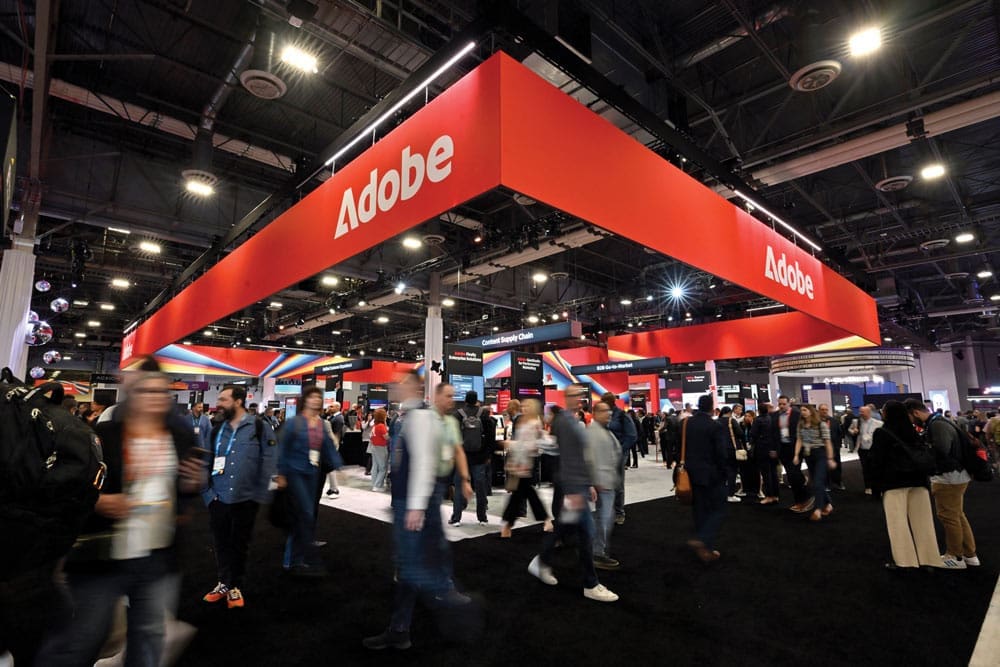Adobe Is Building The Future
Adobe knows how to put on a good show and their 2025 Adobe Summit was no exception. With more digital screens and wizz bangery than an episode of The Mandalorian, this year’s event was quite the spectacle, but the real stars of the show were Adobe’s roadmap and tools for the future. Held in Las Vegas and streamed globally, including here in New Zealand, the event unveiled a sweeping vision of what’s next, not just for marketing or design, but for how businesses connect with their customers. From customer acquisition to content creation, Adobe sees a future driven by agentic AI, deeply personalised experiences, and the seamless orchestration of data, creativity and trust.
The big theme of this year’s Adobe Summit was the shift from customer experience management to customer experience orchestration. It’s a nuanced but important distinction. Management is reactive and focused on reporting, tracking, and optimising while orchestration is active. It is about coordination, adaptability, and a system of interconnected tools working in harmony and in real time. Adobe’s approach is not just about deploying more automation. It’s about designing experiences that adapt dynamically to each individual while being powered by trusted data and executed with intelligence that understands context and intention.
To enable this, Adobe has introduced Agent Orchestrator, a new capability in Adobe Experience Platform that provides the foundation for businesses to orchestrate purpose-built AI agents. These agents are designed to support marketing teams across a wide range of functions. They help build audiences, generate content variations, run web optimisations, analyse performance data, and even manage campaign setup. Agent Orchestrator can automate repetitive, technical tasks so marketers can focus on strategy and storytelling. It isn’t a standalone app either, it’s a deeply embedded capability that works within Adobe’s broader ecosystem, drawing on real-time data and working across Experience Cloud applications.
Each agent in Adobe Experience Platform is powered by secure, first-party data. This means that every interaction and decision is based on accurate, up-to-date information. Businesses can customise these agents to suit their workflows and branding, with controls to set parameters for tone, risk thresholds, privacy compliance and more. They’re also composable, meaning businesses can integrate them into existing martech stacks, connect them with internal systems via APIs, and continuously refine how they behave.

Adobe’s AI agents are also tailored to respect brand identity, compliance rules and governance frameworks. This trust-centric design philosophy is also baked into Adobe Brand Concierge, another AI-powered solution introduced at Summit. Adobe Brand Concierge allows companies to deploy customer-facing, multimodal AI agents that stay firmly within brand voice, tone and values. Whether interacting via text, chat, voice or visual media, these agents are built to act like fully briefed brand representatives.
“The future of brand interaction isn’t about static guidelines,” says Sundeep Parsa Adobe’s VP of Experience Cloud. “It’s about having intelligent agents that understand your tone, message, and boundaries and can scale that understanding to every touchpoint.”
Parsa describes it as a logical evolution of Adobe’s mission.
“We created the category of Customer Experience Management. Now, we’re evolving it into Customer Experience Orchestration,” he says. “After a very long time, it feels like we are literally like kids in a candy store. When you combine predictive AI with GenAI and LLMs, it is truly transformational.”
To bring this new infrastructure closer to day-to-day workflows, Adobe announced the Adobe Marketing Agent for Microsoft 365 Copilot. This integration connects Adobe’s data and insights directly to everyday productivity tools like Outlook and Teams. Marketers can query segments, generate messaging, analyse results or trigger actions, all without leaving their primary workspace. For teams already embedded in the Microsoft ecosystem, it’s a frictionless way to bring marketing intelligence into the everyday decision-making cycle.
These integrations are a part of Adobe’s broader goal to embed intelligence into every part of the customer experience lifecycle. Adobe Experience Platform already processes trillions of segment evaluations and billions of customer interactions daily. This massive operational scale enables Adobe’s AI agents to identify behavioural signals, adapt content, and orchestrate experiences in real time. It also provides the foundation that governs how these AI agents are deployed, customised and managed across an organisation.
“We’re not just launching AI agents. We’re giving companies a way to build their own, agents that know their customers, understand the moment, and act accordingly,” says Parsa.
Agentic Experience Orchestrator allows businesses to build and manage their own network of AI agents. These agents can be given distinct roles, like performance analysis, testing recommendations, or audience discovery and be configured with access controls, brand models, and escalation logic. They can also be assigned to specific moments across the customer journey. For example, one agent may monitor content effectiveness across a campaign, while another helps generate product recommendations for a returning user.
Adobe is also applying these tools to the B2B environment. Updates to Customer Journey Analytics B2B Edition and Journey Optimizer now give enterprise teams more visibility into the full customer lifecycle, from first contact through to closed deal and renewal. The B2B-specific interface maps individual stakeholders, buying committees, and sales stages, while AI agents help identify likely decision-makers, track engagement signals, and coordinate timely outreach.
As always, Adobe is extending these agentic AIcapabilities through its partner network. This includes new and continued strategic partnerships with Acxiom, Amazon Web Services, Genesys, IBM, Microsoft, RainFocus, SAP, ServiceNow and Workday to enable seamless execution of use cases across agents for customer service, enterprise resource planning, human resources, collaboration and productivity, and data management. Adobe also announced expanded agency and system integrator partnerships with Accenture, Deloitte Digital, EY and IBM to drive customisation across industries and use cases.

“Partnership is the angle that we are focused on… to build out those verticalised capabilities,” says Parsa. “We’re working with partners who have so much expertise built over decades, enabling us to unlock those use cases much faster.”
Closer to home, one of the most relevant real-world applications comes from Auckland International Airport, which is using Adobe Experience Platform, Journey Optimizer, and Firefly to unify its customer data and deliver tailored communications across the airport ecosystem.
“Adobe Journey Optimizer allows us to create a connected ecosystem between our digital customer touchpoints. That’s helped us to achieve a positive return on investment in a short period of time,” says Richard Wilkinson, Chief Digital Officer at Auckland International Airport.
With millions of passengers moving through the airport annually, and a complex mix of travel, retail, and transport touchpoints, the team needed a solution that could scale communications across multiple use cases, from parking to flight disruptions, while still feeling personal. Since rolling out AI-powered orchestration, Auckland Airport has reported a 72% increase in automation revenue and a 10% improvement in open rates, driven by more timely and relevant messaging.
“We have been really impressed with the initial positive results we are getting using AI Assistant. It is early days still, but it is exciting,” says Paloma Vivanco-Coutts, Digital Channels Manager. “We hope it will inspire more adoption which will help us to connect all of the data and business units that we need to create a truly end-to-end experience that follows travellers throughout their time at the airport.”
By integrating generative AI into content workflows, the marketing team has also cut email production time by 40%, allowing them to act faster during disruption events such as weather incidents or operational delays. Campaigns using Firefly-generated subject lines and creative variations have shown a fivefold increase in transaction rates, showcasing the impact of intelligent, agile content delivery.
Beyond data and orchestration, Adobe has continued expanding its suite of creative tools, particularly GenStudio, a platform designed to manage the full content supply chain, from planning and creation to activation and performance.
GenStudio’s new Foundation homepage centralises workflows and provides unified access to tools across Adobe Creative Cloud, Firefly, and Experience Cloud. Teams can now build briefs, track assets, collaborate on iterations, and publish directly to marketing channels, all from one interface. It supports both Adobe’s native GenAI models and third-party LLMs, enabling flexibility based on creative needs and regulatory environments.

For performance marketers, Adobe has also introduced GenStudio for Performance Marketing, which includes direct publishing to platforms like Google, LinkedIn and Microsoft. These integrations cut out redundant steps between content creation and deployment, accelerating time to market and tightening the loop between creative and performance.
At the heart of this ecosystem remains Adobe Firefly. Firefly’s latest evolution allows for enterprise fine-tuning, meaning it can now be trained on a brand’s own content to deliver even more on-brand visuals, copy, and designs. The focus remains on commercial safety, all Firefly-generated content is trained on Adobe-owned or licensed material and comes with built-in rights for commercial use.
Adobe Express has also matured significantly, evolving from a creator tool into a true enterprise content platform. Now integrated with Adobe Workfront, it supports governance features such as locked templates, metadata enforcement, and automated brand checks, making it possible for cross-functional teams to build content at scale while staying compliant.
The theme of speed and autonomy carries into experimentation as well. Adobe’s new Experimentation Agent and Sites Optimization Agent aim to make multivariate testing a standard operating model. AI helps teams identify high-impact areas for testing, generate variants, and interpret results.
“We’re making experimentation a built-in habit,” says Parsa. “With these new tools, it’s easier to try something, learn fast, and move forward, even in large organisations.”
From campaign creation to customer service to real-time journey orchestration, Adobe has built a system that doesn’t just automate tasks, it enables organisations to act with greater intelligence, agility, and empathy.
For New Zealand organisations, whether in tourism, export, finance, retail, education, or B2B, the benefits are tangible. Agentic AI means faster decision-making. Personalisation at scale means more relevant customer engagement. Unified data means better alignment across teams.
But as the tools evolve, so too must strategy, governance, and internal capability. Adobe’s 2025 Summit made one thing clear: the technology is ready. Now it’s about how we use it.

